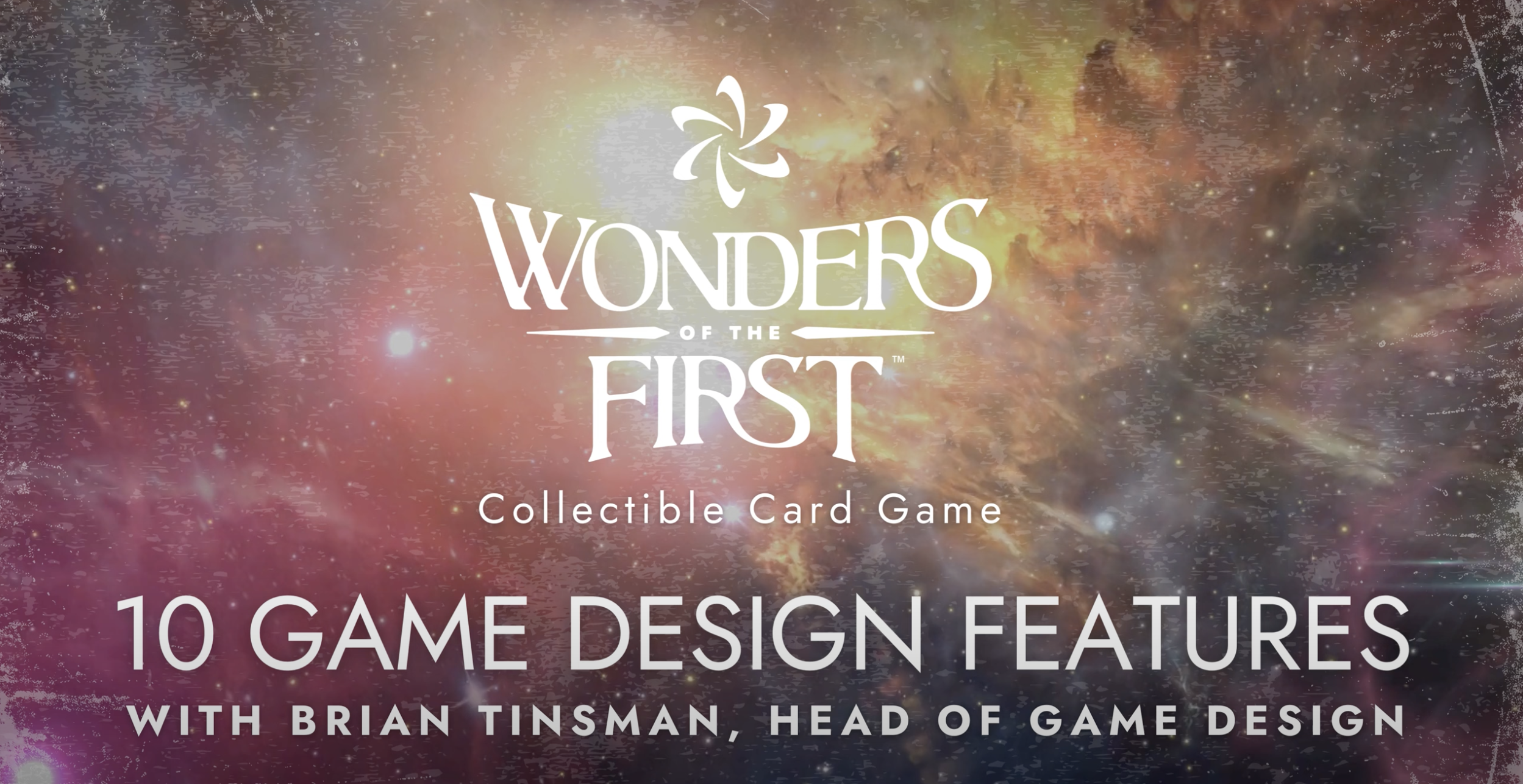
10 Game Design Features
Hi, I’m Brian Tinsman. I’m the Head of Game Design at Wonders of The First CCG. Today I’m going to share 10 features of Wonders of the First game design that make it different from other CCGs.

#1 – SEVEN ROUNDS
Wonders has a fixed seven round game length. This is nice because you know you’re going to have seven rounds to pull off your plan in your deck.
In other games sometimes games can end too soon or stretch on too long. This one’s much more predictable and it kind of shows that people like to have time to put their plan together.
This is why formats like Commander have sort of artificially extended game length so that people will have time to put out their seven and eight drop cards. That’s great but there’s certain strategies that kind of depend on an early win. For example, “aggro” strategies want to win on turn three or four and then fall apart after that or early combo strategies.
We had to adapt the game for that. This is one of the reasons why when you capture Stones they generate energy for you. That’s breaking conventional wisdom. Most game design teams will tell you that your Victory condition should not generate extra resources because it will have a Snowball Effect.
If you get ahead early then it’s hard to catch up to that person who took the early lead but in this game you can kind of turtle up and buy your time until the right time to do a big comeback. It’s quite balanced.
There’s a lesson that a lot of CCG tuning teams end up learning when they are balancing the different strategies. It’s kind of intuitive to think that the power of the offensive cards and the power of the defensive cards should be somewhat similar in strength. But what happens is that if they’re evenly matched then a certain amount of games end up being highly defensive. The action grinds to a halt and in the second half of the game nothing happens or it goes on too long.
You have to tune up your aggro offense. This should be substantially better than the defensive cards in terms of power level so that there’s always action always and always motion and dynamic things happening to upset the stasis of the game board.
#2 – SEVEN REALMS
Wonders has seven realms in which battles can take place. In the first round only one is open and then a new realm opens with each round until there’s seven realms open. Over the seven rounds you can play anywhere you want in any of them.



You have this increasing freedom to play and make decisions over the course of the game. There is a skill to getting your opponent to play where you want them to play. If you take a stone early – and you’ve got them thinking or getting mad about how they’re going to take it back – then as the NEXT realm opens there’s a stone free and available there BUT they are playing to get the previous realm stone that you took back!
We’ve seen games happen where players spend the whole game fighting over the first two stones when there’s five Stones sitting out there available for anyone to take. There’s a kind of sunk cost fallacy that neither one wants to give up on those two battles that they’ve put so many cards and so much energy into trying to get.
So the skill is can you make them play where you want them to play?
#3 – THE ACTION ECONOMY
The next feature is the action economy. We have two resources that players get every round. The first is Energy – which is the sort of familiar way to pay for costs of cards from your hand.
And then we have Actions – which you can use to play a card, activate a card on the board attack, or draw a card.
Having two resources like that provides a nice resource management challenge as you try to execute your plan across the board. It also provides a nice balancing feature because we do
have some crazy combos and some endless loops. In general when you run out of actions you can’t use them anymore and they have a finite end point. Meaning they won’t allow a super easy combo win on the spot.
Because of that we can push the boundaries a little bit of the kinds of cards that we can release. They have this limiting balancing factor in most cases so we can do crazier, more exciting cards than you would otherwise be able to do in a CCG.
#4 – BUILD POINTS AND DECK RATINGS
The next feature is build points and deck ratings. Every card has a buildpoint value that is not on the card it’s maintained in the card database and we adjust it and tune it every now and then depending on that card’s impact in the metagame.

So you can take your deck and add up the point value of all of the cards in your deck and you get a deck rating. Now you can use that for tabletop matchmaking. What this does is it fundamentally reframes the problem of overpowered cards as a matchmaking problem. You no longer have this problem of a new player who has to come in and drop a thousand dollars to have a competitive deck because that new player can come build a 200 Point deck and find another player who also has a 200 Point deck that is more or less fair – and more or less evenly matched. And if it’s not fair and not evenly matched after a while we’ll be able to re-balance those cards so that they do become more fair and evenly matched.

#5 – COMPETITIVE PACK RIPPING
As game designers we don’t often talk about the pack ripping experience as much as we should. Depending on the game that you’re looking at there are just as many videos out there about opening packs as there are about actual games being played.
People love opening packs and they love doing it with friends.
Now that we have this buildpoint system you can open a pack and look at the total points across all of the cards that you opened. If you get some serialized cards or some other special cards you can have a multiplier and now you can have a quantifiable score on the pack that you just opened and try to beat your friend’s high score. This is something players love doing. Now we’re going to put a number on it so you can actually tell who won.
#6 – DECISION FLOW & MOMENTUM
One thing that I learned from working on mass market games is that if you want to put a giant roadblock in the middle of the game you give players a huge complex decision with many options. If you want to keep momentum and action moving forward in the game you make sure that each decision has a manageable amount of options and lots of those small decisions happen in a row. That’s what we’re going for.
We want decisions in general to be around 3-4… which is a reasonable number of options instead of 10-12 different things you could do.
So how do we do that with our game?
We remove some decisions about resources – we have automatic resource generation – and we have a game state board where you can easily see where you’re winning and losing. This way you can easily plan out where you’re going to attack where you’re going to play next. Usually it only kind of makes sense to try to win in two or three places in any given board situation.
We have a board state that moves from simple to complex but you follow that complexity every step of the way so it’s quite easy to track in your head where everything is, what it’s doing, and why it’s there.
We also have a very straightforward “I do one thing on my turn” and “you do one thing on your turn” back and forth so there is no waiting for the other person to respond to see if you can actually complete the action that you started. It has a lot of gameplay depth but nice clean action oriented forward momentum rules.
We also did a lot of work on the card set to make sure that card abilities themselves we’re not slowing down gameplay and we’re keeping things interesting. We’re quite low on Deck searching. We’re quite low on modal cards where it’s not always clear which ability of the card that you want to use at which time we want to keep those decisions elegant, clean, and moving forward at a lively pace.
#7 – HIGH EFFICIENCY RULES ENGINE
Wonders has a high efficiency rules engine. We create more gameplay with less rules infrastructure than any other CCG that I know of. A lot of times in a CCG the rules get very bloated because the more based rules you have the more time cards you can make that break them and the more card design space you get so there’s an incentive to have a lot of complicated turn steps.
We have a game where we prefer to break the rules of the card layout that you see in front of you. That lets us have more simple, more elegant rules, with fewer decisions and keep that decision momentum moving forward.
#8 – LOW CHARACTER COUNT ON CARDS
Now we come to one of my favorite topics which is low character counts in rules text of cards. When Magic: The Gathering’s Beta came out it was an average of about 18 words in a text box per card. When I was leading Magic design teams I constantly had to reign in my designers not to put in so many abilities on cards. It’s very easy and very tempting to just load up more and more abilities. It’s lazy and it’s inelegant. You may have heard that when everyone’s super no one will be.
Today I believe Magic rules text is about over 30 words per card on average.

Wonders of The First CCG is coming in at 15 words per card on average. We’re going to try and see if we can get it even lower!

This is something I press for on every design team that I’m ever part of: pick the right abilities, make them elegant, make them needed and a reason to be on that card instead of putting card advantage and a big beater and evasion and protection all on the same card.
No. That is the player’s job to figure out how to do that.
The designer’s job is to give them the tools and the pieces they need to put those together.
#9 – BIG ART
Now we come to one of my favorite parts of the game which is the HUGE art. All of our art is two to three aspect ratio. It takes up the entire space of the card face.

How can we do this when other cards generally don’t do it? It’s because we have that low character count in our rules text which gets out of the way of enjoying all of that art that low character count comes from our high efficiency rules engine so when we started having efficient well-designed clean rules elegantly designed card abilities and low character count that unlocks the ability to do big beautiful bold cards you can recognize them way across the table they catch your eye when you walk into a game store and you see them down there.
I love that about this game.
#10 – NESTED SET DESIGN
Our next feature is nested set design. We have a huge set with a pauper style format built into the game – like a game within a game. Our Commons, Uncommons, and Rares – that’s our three lowest rarity tiers – are 90% the size of the original Magic beta set.
Our Commons alone are 90% the size of the original Pokémon base set. This means that when you play this game you can opt to play the “high collectibility version” OR the “low collectibility version” and have a great experience that holds up with the best CCGs in the marketplace.
How do we do this?
We deliberately made sure that strategic options and build arounds – everything that you need for a good variety of gameplay: resource ramp, aggro, control, removal, tribal build arounds – were all available at those lower Rarity tiers.
You’ll see them immediately when you open a few booster packs. If you end up getting some Epics and Mythics and you want to play the version that’s low collectibility, you can trade those away for the automatic popper style format included in every booster.
That covers my 10 features of Wonders of The First game design. There’s a lot more features I can talk about but we’ll save them for another time.
CONCLUSION
I also want to say that I love collectible trading card games of all kinds. When I criticize Magic or other games please take that in the positive light that it’s meant for.
I want to make positive changes in the industry. I want to solve some of these problems. Our whole game design team does. It’s incredibly exciting to get to build a game from the ground up that looks like it is taking on some of these problems successfully… It is finding innovative solutions… it’s been proven out quite a bit in our play testing already. It’s exciting to see what’s going to happen next.
Thanks, Stoneseekers!
Brian
Head of Game Design, Wonders of The First
PS. If you want to stay up-to-date on the latest tips and tricks for Wonders of The First CCG, subscribe to our YouTube channel and join our Discord.



